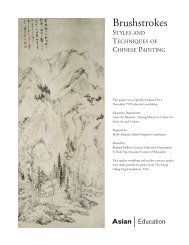Sacred Arts of Tibet (.pdf) - Asian Art Museum | Education
Sacred Arts of Tibet (.pdf) - Asian Art Museum | Education
Sacred Arts of Tibet (.pdf) - Asian Art Museum | Education
Create successful ePaper yourself
Turn your PDF publications into a flip-book with our unique Google optimized e-Paper software.
What’s inside?<br />
<strong>Sacred</strong> <strong><strong>Art</strong>s</strong> <strong>of</strong> <strong>Tibet</strong><br />
Part palace, part fortress, part treasure-house, part temple, part tomb, part administrative<br />
center, it is a titanic building <strong>of</strong> over 900 feet long, with countless rooms. Over the centuries<br />
it became the repository for <strong>Tibet</strong>an culture. Store rooms were filled with priceless<br />
tangkas (religious paintings on silk), vast libraries, religious statues made <strong>of</strong> precious metals,<br />
and endless other things.—Hicks, p. 36<br />
In 1959, the Chinese invaders tried first to destroy it with bombs, but it is so strongly built, with walls 26<br />
feet thick at the base, that they gave up and instead removed the precious contents and turned it into a<br />
headquarters <strong>of</strong> the army.<br />
The red buildings at the center are the Potrang Marpo, the red palace, where religious services took place.<br />
The Potala was also the seat <strong>of</strong> the <strong>Tibet</strong>an government until the Chinese take-over. Among the many<br />
rooms are some impressive throne rooms where the Dalai Lamas would receive <strong>of</strong>ficial guests. It even<br />
houses the stupas, which contain the mummified remains <strong>of</strong> bodies <strong>of</strong> the former Dalai Lamas (see Slide<br />
5 for more on stupas). The Potala has become a symbol <strong>of</strong> <strong>Tibet</strong>an nationhood.<br />
What was it like to live in this palace as the Dalai Lama?<br />
Famous stories about Tenzin Gyatso, the Fourteenth Dalai Lama, tell <strong>of</strong> his adventures in the Potala.<br />
Since his position prevented him from mixing with the people <strong>of</strong> Lhasa like other boys his age, he<br />
explored the city from the ro<strong>of</strong>-top <strong>of</strong> the Potala by spying on the people below with telescopes and binoculars.<br />
(Harrer, p. 185) He lived in the Potala from the age <strong>of</strong> 4 in 1939 until the age <strong>of</strong> 24 in 1959,<br />
when he left his country for exile in India. For first hand accounts <strong>of</strong> the Potala, see Readings 1 and 2.<br />
Discussion Points/Teaching Suggestions<br />
1) Read and discuss the descriptions <strong>of</strong> the Potala by the Dalai Lama and Heinrich Harrer (the Austrian<br />
mountaineer who escaped a British prison in India to <strong>Tibet</strong> in 1943; Seven Years in <strong>Tibet</strong>, starring Brad<br />
Pitt, tells <strong>of</strong> his adventures ). (Readings 1 and 2.) Have the students write a descriptive passage <strong>of</strong> their<br />
own about an extraordinary place they have visited, or one they imagine. They should try to give the<br />
reader a visual picture <strong>of</strong> the place and the people in it.<br />
2) Compare The Potala with other great buildings and monuments, such as the pyramids in Egypt,<br />
the Vatican, the Forbidden City in Beijing, the US Capitol, PacBell Park, San Francisco City Hall, etc.<br />
Discuss the functions <strong>of</strong> the buildings—are they seats <strong>of</strong> government? religious institutions? How does the<br />
way they are built and decorated convey ideas? Does the building look like it was meant to defend attack<br />
or does it look inviting?<br />
30<br />
<strong>Asian</strong> <strong>Art</strong> <strong>Museum</strong>
















